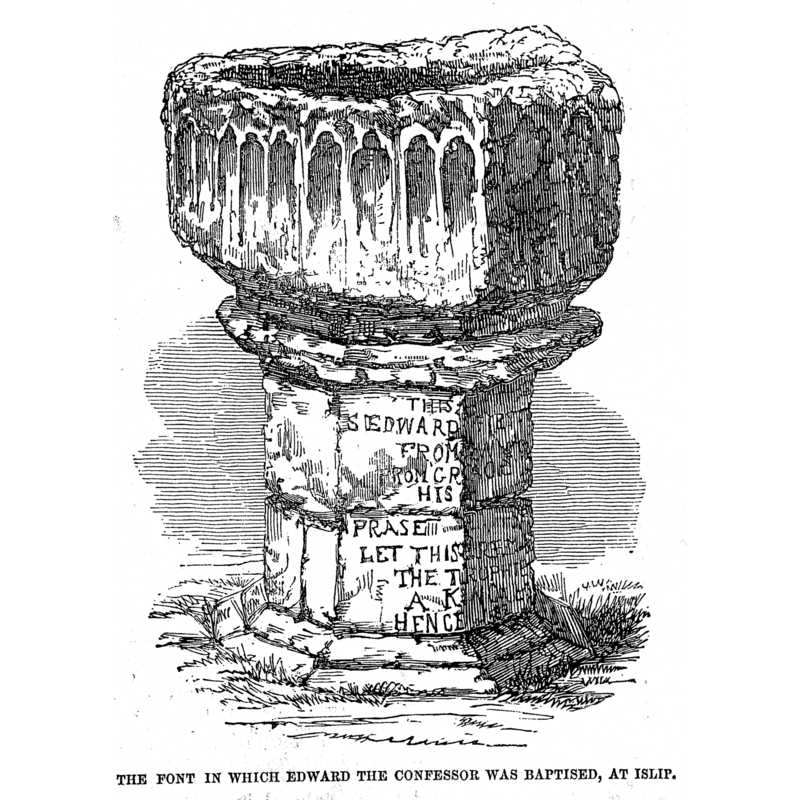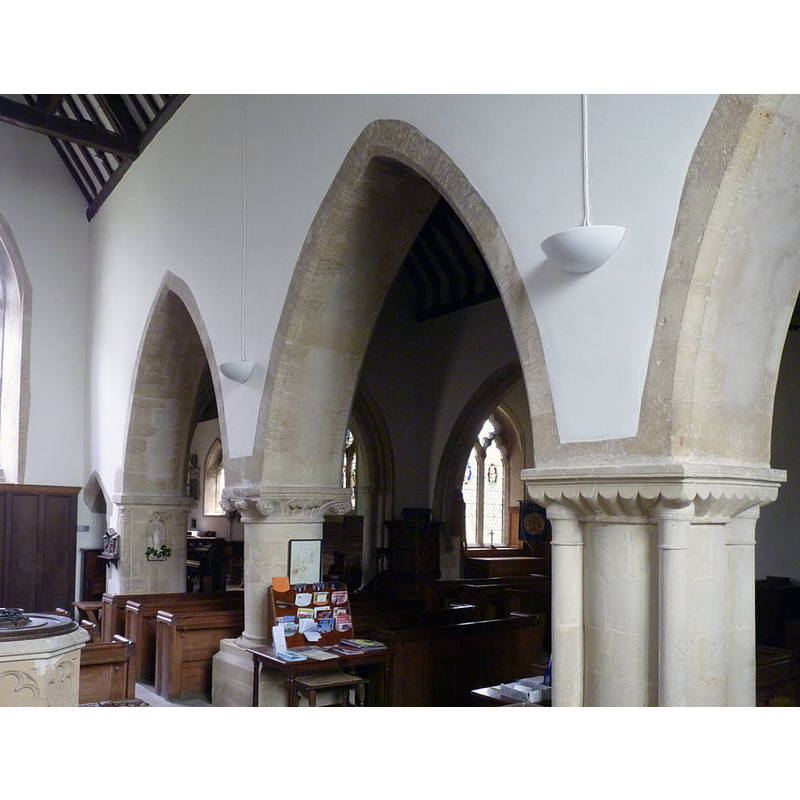Islip nr. Kidlington No. 1 / Githslepe
Results: 6 records
design element - architectural - arcade - blind - trefoiled arches
design element - motifs - tracery
inscription
view of church exterior - southwest view
view of church interior - north aisle - looking west
INFORMATION
FontID: 06295ISL
Object Type: Baptismal Font1
Church/Chapel: Parish Church of St. Nicholas
Church Patron Saints: St. Nicholas of Myra
Church Location: Church Lane, Islip, Oxfordshire OX5 2SN, UK
Country Name: England
Location: Oxfordshire, South East
Directions to Site: Located off (N) the B4027 [aka Bletchingdon Road], across (E) the A34 from Kidlington, just N of the River Ray, NNE of Oxford
Ecclesiastic Region: Diocese of Oxford
Historical Region: Hundred of Hirtlington [in Domesday] -- Hundred of Ploughley
Font Location in Church: Inside the church
Century and Period: 14th - 15th century, Late Decorated? / Early Perpendicular?
Font Notes:
Click to view
There is an entry for this Islip in the Domesday survey [http://opendomesday.org/place/SP5214/islip/] [accessed 12 December 2016], but it mentions neither cleric nor church in it. Kennett (1818) notes the font and some of its wanderings. The Lewis' Dictionary of 1848 has: "the old font, used at the baptism of Edward the Confessor, in 1010, was removed during the rebellion, but has been restored to the parish, and is now [i.e., ca. 1848] in the gardens of the rectory". Dunkin (1826) notes: In the font at Islip an old lady used to keep meat to cram her turkeys, and that the turkeys all died" [cf. infra for an earlier version of this story in Hearne]. Gardner's Gazetteer (1852) [www.historicaldirectories.org/hd/d.asp] [accessed 30 June 2007] notes in its entry for Bicester: "A baptismal font was preserved for many centuries in the barn of the Red Lion Inn, which according to tradition was Edward the Confessor's chapel, and the font that in which the same king was christened. This font after many changes of ownerships, may be seen in the garden of Mr. Wilkiam Paxton of Layton farm, near Bicester". This same source (ibid.) notes in its entry for Islip: "The font belonging to this chapel, and in which it is said king Edward was baptized, was preserved until the year 1660, in an old barn in the yard of the Red Lion Inn, the supposed remains of the chapel. In that year it was purchased and removed to Kiddington, where it ramained for many years, in the garden of the mansion there, in the possession of the Browne family. It is now in the garden of Mr. William Paxton, of Layton farm, near Bicester. (See page 493) The block of stone in which the basin of immersion is excavated is unusually massy. It is octangular in shape, and the outside is adorned in tracery work. The interior diameter of the basin is 30 inches, and the depth 20. The whole, with the pedestal which is of a piece with the rest, is 5ft. 5in. high, and bears the following inscription:-- This sacred Font Saint Edward first receavd. / From Womb to Grace, from Grace to Glory went / His virtuous Life. Ti this fayre Isle beqveth'd. / Prase.... and to vs but lent. / Let this remaine, the Trophies of his Fame, / A King baptized from hence a Saint became. -- Then is inscribed:-- 'This Fonte came from the King's chapell in Islip'. Though this relic is evidently an ancient piece of workmanship; yet Warton's opinion is that, "the tracery and construction do not agree with the rudeness of art in so barbarous a time as that of Edward the Confessor"." [i.e., 1003-1066]. Illustrated in a 29 May 1840 drawing by Henry E.L. Dryden, now in the Sir Henry Dryden Collection, Northamptonshire. A font is described and illustrated in an article in The Illustrated London News issue of December 2, 1854, entitled 'The font in which Edward the Confessor was baptised'. The article is quite a 'tour de force' in the way it insists in establishing the 'trueness' of the object [despite the inescapable fact that the font was most likely made about 400 years after Edward!] Nonetheless, the details of the font's wanderings since 1660 constitute valuable information that outweighs the absurdity of the claim: "This chapel [i.e., the Royal Chapel in Islip] contained the font in which the Confessor was baptised. It was taken from the chapel by Sir Henry Brown, in 1660, and was placed in the garden of the mansion-house at Kiddington, near Woodstock. It subsequently came into the posession of Mr. Mostyn Brown, afterwards Lord Vaux; of whom it was purchased by the late Sir G.O.P. Turner, Bart., for £400, and sent to Langford, near Bicester, Oxfordshire, the residence of Mr. Paxton, elder brother of Sir Joseph. Some little time afterwards it was, at the earnest solicitation of Dr. Ireland (then Dean of Westminster), removed back to Islip, and stored in the garden till the death of Sir G.O.P. Turner; when it was again placed in the charge of Mr. Paxton, and it remained at Langford until the 15th of September last [i.e., 1854], when it was sold by auction, by direction of the late Baronet's trustees; and Mr. W.C. Turner, of Bicester, became the fortunate purchaser. There is no doubt of the veritable originality of this most interesting relic. Plot in his 'Oxfordshire', 'Hearne's Gloss.' and his 'Preface to Curious Discourses' (1720), and Wood's Manuscripts in the Ashmolean Collection in the Museum, all bear testimony to this; and show that not merely historical facts, but the popular traditions of the country in their times, pointed unmistakeably to this piece of sculptured stone as the receptacle of the holy fluid used at the baptism of the Confessor 850 years ago. Hearne has recorded 'that an old lady kept meat to cram her turkeys in this font, but that the turkeys all died.' On the pedestal on which the font stands is the following far more modern inscription: 'This sacred Font Saint Edward first receavd / From womb to grace; from grace to glory went / His virtuous life. To this fayre isle bequeathd / Prase ... And to us but lent. / Let this remaine -- the trophies of his fame; / A king baptised from hence a saint became.' There is also inserted in the pedestal, 'This Fonte came from the King's Chapel, at Islip." A drawing accompanies the above text in The Illustrated London News, with the following caption and added remarks: [caption]: "The font in which Edward the Confessor was baptised, at Islip"; [remarks]: "The annexed Sketch of the Font was recently taken, and is a correct representation. The interior is circular, whereas the external shape is octagonal, with specimens of sculpture on each side in style differing one from another. From this circumstance, some antiquaries have supposed that the font is not so ancient as it professes to be; but by far the more numerous of those who have interested themselves on the subject are of opinion that the monks, from a feeling of veneration, made such external ornamental additions as the taste and style of their day suggested." Regardless of the journalist's enthusiastic attempt, the font must be dated around the 14th century; if the sketch is as true as the ILN [cf. supra] claims, the trefoil arches of the one side are a dead giveaway; the presence of an assortment of decoration and tracery patterns is a coomon enough occurrence on fonts of the late-Decorated and early-Perpendicular periods. Noted in Sherwood & Pevsner (1974): "Octagonal, and with quatrefoils on all faces. Perp[endicular]." Murray (1882) writes: "the font in which he is said to have been baptized, though manifestly of the time of Edward I. [i.e., 1272-1307], is preserved in the rectory garden. It long remained in a barn of the Bed Lion Inn at Islip, whence it was removed to ornament a garden at Kiddington, where, as Hearne records, an old lady kept her meat to cram turkeys in it, but the turkeys all died. Thence it went to Layton Farm, near Bicester, next, being presented to Lady Jersey, was placed in the ch[urch] of Middleton Stony, but has now been restored to Islip. It bears the inscription.-- 'This sacred font Saint Edward first receiv'd / From Womb to Grace, from Grace to Glory went / His virtuous life. To this faire Isle bequeathed / Prase [sic]... and to us but lent. / Let this remaine, the Trophies of his Fame, / A King baptised from hence a Saint became.'" A recent [2005] article by Tim Healey in the Limited Edition Online entitled 'A King and a saint' revisits the "mysteries of the Confessor's Chapel and adds that "the building was desecrated under Cromwell's Protectorate when the font was taken away and used as a wash basin at Islip's Plume of Feathers Inn." [was that before or after the turkeys died?]. Healey (ibid.) further suggests that the font's claim to antiquity may have some base: "Just possibly the 14th century work was cut into the masonry of a font more ancient in origin" [NB: this is probably the same font that appears listed in this Index under Bicester]. The Victoria County History (Oxford, vol. 6, 1959) notes: "According to tradition there was a church at Islip in the early 11th century in which Edward the Confessor was baptized. Gervase de Blois, Abbot of Westminster 1137–57, granted the church at Islip to Helias, decanus, in return for half a mark of silver a year. [...] Much of the church was rebuilt in the 14th century, but traces of the 12th-century church can be seen in the massive piers and arches which separate the north aisle from the nave, and at the west end of the south aisle, where a single roundheaded window survives. [...] The octagonal font, on a tall octagonal base, has a quatrefoil panel on each face." The VCH (ibid.) further notes: "A building known as the Confessor's chapel stood on the north side of the church until the 18th century. [...] it appears unlikely that the chapel was built before the 12th century [...] The chapel contained a font traditionally associated with Ethelred's palace and said to be the Confessor's baptismal font; it was desecrated during the Commonwealth and used at the 'Plume of Feathers' for mixing turkey food. After passing through various hands it was given to Middleton Stoney church by Lady Jersey." [NB: this location not to be mistaken with Islip St Nicholas in Northamptonshire -- cf. corresponding Index entry]
COORDINATES
Church Latitude & Longitude Decimal: 51.823045, -1.236776
Church Latitude & Longitude DMS: 51° 49′ 22.96″ N, 1° 14′ 12.4″ W
UTM: 30U 621518 5742827
MEDIUM AND MEASUREMENTS
Material: stone
Font Shape: octagonal (mounted)
Basin Interior Shape: round
Basin Exterior Shape: octagonal
INSCRIPTION
Inscription Language: English
Inscription Notes: The inscription could be 17th- or 18th-century[cf. FontNotes]
Inscription Location: on the stem of the base
Inscription Text: "'This sacred Font Saint Edward first receavd / From womb to grace; from grace to glory went / His virtuous life. To this fayre isle bequeathd / Prase ... And to us but lent. / Let this remaine -- the trophies of his fame; / A king baptised from hence a saint became."
There is also inserted in the pedestal: "This Fonte came from the King's Chapel, at Islip"
Inscription Source: [cf. FontNotes]
REFERENCES
"The font in which Edward the Confessor was baptised", XXV, 715 (Dec. 2, 1854), The Illustrated London News, 1854
Victoria County History [online], University of London, 1993-. Accessed: 2016-12-12 00:00:00. URL: https://www.british-history.ac.uk.
Gardner, Robert, History, gazetteer and directory of the County of Oxford, comprising [...], Peterborough: Printed and published by Robert Gardner, 1852
Healey, Tim, "A King and a Saint", Limited Edition Online: The Magazine for Oxfordshire, 2005
Kennett, White, Paroquial antiquities attempted in The history of Ambrosden, Burcester, and other adjacent parts [...], Oxford: Clarendon Press, 1818
Lewis, Samuel, A Topographical Dictionary of England, Comprising the Several Counties, Cities, Boroughs, Corporate and Market Towns, Parishes, Chapelries, and Townships, and the Islands of Guernsy, Jersey, and Man, with Historical and Statistical Descriptions [...], London: S. Lewis, 1831
Murray, John [the firm], Handbook for travellers in Berks. Bucks and Oxfordshire, including a [...], London: John Murray, 1882
Pevsner, Nikolaus, Oxfordshire, Harmondsworth: Penguin Books, 1974
Sheahan, James Joseph, History and topography of Buckinghamshire, comprising a general survey of the county, preceded by an epitome of the early history of Great Britain, London; Pontefract: Longman, Green, Longman, and Roberts; William Edward Bonas [...], 1862

![[cf. Inscription area and Font notes]](/static-50478a99ec6f36a15d6234548c59f63da52304e5/compressed/0051007011_compressed.png)



